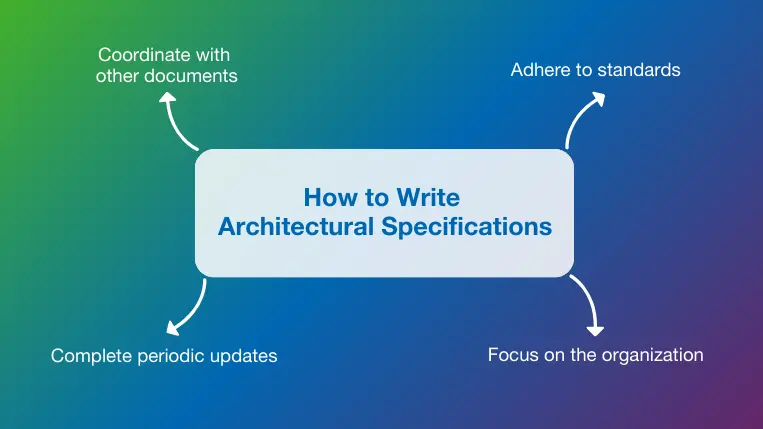24 mins read
What are Architectural Specifications? Key Definitions, Responsibilities & Best Practices

Architects are sometimes perceived as creative geniuses hunched over drafting tables or computer terminals as they produce sketches, models, and CAD drawings to convey their ideas to builders and clients. These important tasks are balanced by less glamorous but equally valuable assignments, including the generation of written architectural specifications that add layers of detail to the project documentation package.
In this blog post, we review the concept of architectural specifications, along with their important uses, categories, and benefits. We also explain how the right software makes it easier to create and manage these essential documents.
What Are Architectural Specifications?
Architectural specifications are written documents that outline the standards, performance requirements, materials, and methods of a construction project. These specifications supplement the architectural drawings, providing a visual representation of the design concept.
These specs guide the successful completion of building projects by providing contractors and other key stakeholders with a clear understanding of deliverables and expectations. This helps ensure construction activities align with the architect’s vision and meet their material, workmanship, and aesthetic design quality standards. Well-written specs also prevent project delays due to change orders and rework.
Who is responsible for architectural specifications?
Architects are typically responsible for architectural spec writing, with assistance from designers, engineers, manufacturers, and other stakeholders. For larger projects, these tasks might be fully or partially delegated to a specifier, an expert in specification writing in architecture and related industries. Input from stakeholders other than the architect might include:
- Structural and mechanical details provided by engineers.
- Information on specific products, appliances, and materials provided by the vendors or manufacturers.
- Instruction on non-standard construction methods provided by specialist designers and other industry experts.
No matter who completes the architect specifications, all information should be clearly conveyed, well-organized, and understandable for anyone performing or overseeing construction tasks. The specifications should also align with architecture and construction drawings so that all resources complement one another and do not cause confusion.
Who uses architectural specifications?
The key players involved in the process eventually become primary users of the documents, since they guide the detailed design and construction processes that follow. Once project activities begin, contractors and subcontractors rely on these specifications to help them understand work expectations and execute them correctly.
Clients also utilize architecture specifications to review the concepts in detail and confirm that the information is consistent with the overall vision and scope they were expecting. An early client review of the documents helps to prevent downstream changes or conflicts during construction.
When are architectural specifications produced?
These valuable documents are typically produced during the design phase of a project. They are usually completed in parallel with architecture and design drawings, and other essential deliverables that become part of the construction contract. Contractors attempting to compile accurate bids during the tendering stage benefit from the clarity of requirements found in these specifications.
Encouraging an architectural specification writer to draft requirements earlier, while the project is still in the conceptual or very early planning stages, is a trend welcomed by clients and construction companies looking for more information to support early decision-making.
Types of Architectural Specifications
Many document types and formats have been developed to clearly convey critical architecture guidelines and constraints, but most specs fall into one of three general categories:
Performance specifications
This type of specification focuses on the desired outcome without dictating specific methods or materials. For example, an architect might specify the height, width, and fire safety characteristics of a brick fireplace without stating the specific type or size of construction brick to be used.
Prescriptive specifications
Unlike performance ones, prescriptive specifications provide more detailed instructions, including specific methods and material types that leave little or no room for interpretation. They might also include step-by-step installation or assembly instructions.
Proprietary specifications
This specification type is a subset of the prescriptive variety, but only specific brand names or manufacturers can be used. A proprietary architecture spec is appropriate when clients prefer specific high-end brands, or the project is a renovation or extension requiring new material finishes and fixtures to match existing patterns.
Benefits of Architectural Specifications
Architectural specs provide a level of clarity that can usually not be attained with drawings alone, which helps to minimize confusion or misinterpretation of project expectations, material choices, and quality standards. Detailed specifications ensure the results will be consistent no matter who performs the work, while providing a basis to evaluate task completion. Additional benefits include:
- More accurate takeoff and construction cost estimation processes based on well-defined material and workmanship requirements.
- Improved schedule performance due to minimized change orders, rework, and communication issues.
- Enhanced alignment between contract requirements and project execution.
- Stringent and consistent compliance with relevant building codes and standards.
Documented specs also improve communication and collaboration between clients and contractors since they provide a common framework for discussion and review. The document management capabilities offered by top construction software providers create a convenient platform for sharing, updating, and reviewing the documentation.
How to Write Architectural Specifications: Tips & Best Practices

All construction specifications must be written using clear and concise language that can be understood by clients and laypeople, as well as subcontractors, vendors, and artisans. Beyond this fundamental requirement, learning how to write architectural specifications involves implementing some logical best practices.
1. Coordinate with other documents
One unique aspect of an architecture spec is its connection to drawings. This relationship allows drawing features to be cross-referenced in specifications, and vice versa. At the same time, this linkage between drawings and specs calls for careful editing and reviews to ensure there are no conflicts between contract document types.
2. Adhere to standards
Industry standards, including CSI MasterFormat, provide guidance for architectural spec writing practitioners. Architects and other contributors can familiarize themselves with these standards to better understand what must be documented and how it should be formatted. Relevant building codes, safety standards, and other industry regulations should also be reviewed to ensure the spec reflects the latest revisions.
3. Focus on the organization
Along with the focus on clarity, conciseness, and completeness that makes specs useful for other stakeholders, document organization is another key attribute of the best. Architectural spec sections should be organized using headers, bullets, and numbering to make the documents easier to follow. The documents themselves should also be organized electronically according to established industry standards.
4. Complete periodic updates
Just as the design drawings require review and updating throughout a project to reflect any changes or adjustments, each architecture spec should be reviewed regularly to ensure it does not diverge from the drawings, regulations, or accepted industry practices. Professional construction document management software makes it easier to complete structured reviews and maintain revision control.
What Can Architectural Specifications Software Do for You?
Along with the wide variety of general software tools available to streamline specification writing, document management, and other important construction tasks, powerful architectural specifications software is purpose-built to improve the speed, accuracy, and quality of specification writing.
RIB SpecLink is a versatile, cloud-based specifications management software that brings automated workflows, data-driven intelligence, and enhanced collaboration to the table for architects, specifiers, and project owners. SpecLink dramatically reduces errors and accelerates writing and editing processes with advanced features including:
- A master database of industry standards, catalogs, and templates that is continually updated to help you maintain compliance.
- Formatting options that allow you to easily expand or contract specifications depending on the application and intended audience.
- Mobile and web-based platforms to support access and collaboration from any browser-enabled device.
- Intelligent links between over 300,000 related paragraphs and sections to ensure changes are automatically reflected in related specification areas.
- Building information modeling (BIM) integration features that link specifications to BIM models and allow stakeholders to assess the impact of design changes instantly.
Go check our RIB SpecLink basics blog for more insights on what our powerful platform can do!
Final Thoughts
Architectural specifications are essential contract documents that support the visual elements of drawings with supplementary instructions and requirements. Creating, managing, and revising them can be challenging and time-consuming for architects and specifiers on busy construction projects.
RIB SpecLink empowers teams to complete their specification writing tasks more efficiently while maintaining full visibility and control. Embedded intelligence automatically identifies document conflicts and other issues to support error-free specification generation with collaboration at the forefront.
If you want to edit your specs 70% faster and benefit from unmatched levels of precision and success, get your free demo for RIB SpecLink today!

Most Recent
24 mins read
25 mins read
24 mins read
21 mins read
Blog Categories

Ebook











